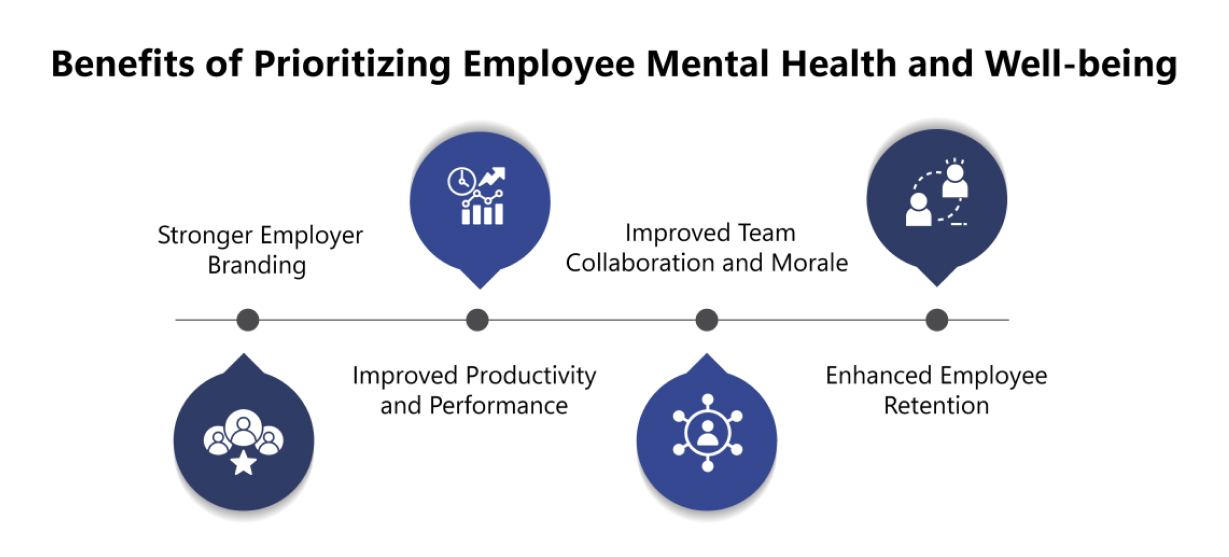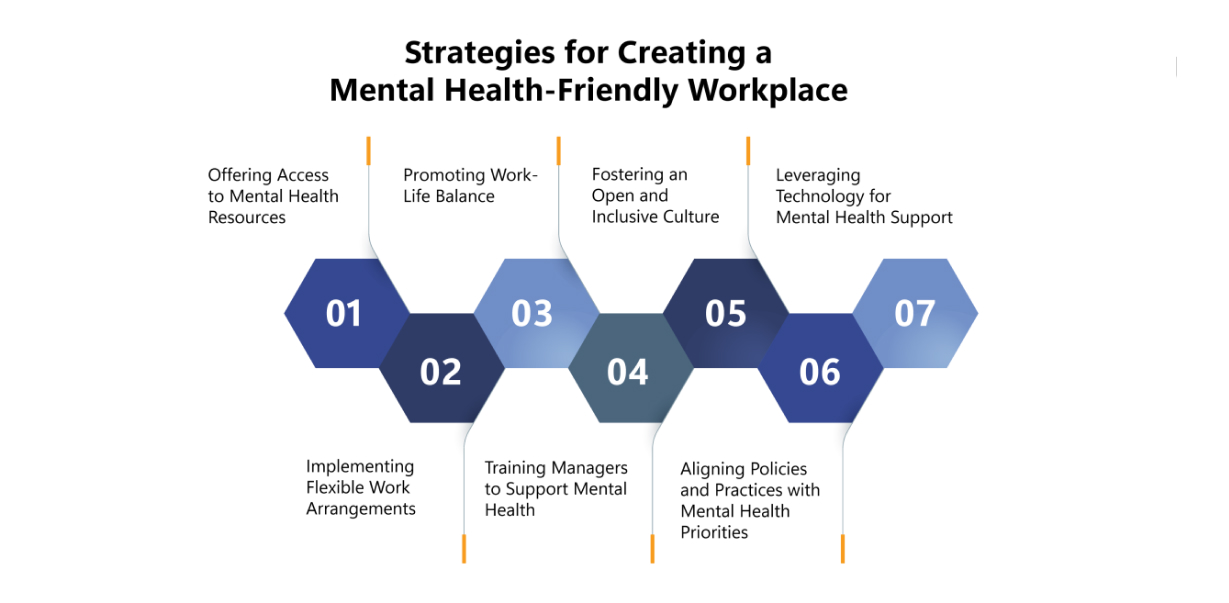
In the year 2025, the corporate landscape has undergone a significant transformation, with mental health and employee well-being taking center stage. As businesses navigate the post-pandemic world, it has become increasingly clear that prioritizing the mental health of employees is not just a moral obligation but a strategic necessity. HR professionals play a crucial role in shaping this new reality, as they are tasked with creating a workplace culture that fosters well-being, resilience, and productivity.
Mental health has long been a taboo topic in the workplace, with many employees feeling reluctant to discuss their struggles openly. However, the events of recent years have brought the issue to the forefront, highlighting the need for businesses to address mental health challenges head-on.
The alarming statistics underscore the direct link between mental well-being and job performance. When employees are struggling with mental health issues, they are more likely to be absent from work, less engaged, and less productive overall.
Moreover, the cost of ignoring mental health in the workplace is staggering. The World Health Organization estimates that poor mental health leads to a global economic loss of $1 trillion annually due to reduced productivity. This figure alone should be a wake-up call for businesses, demonstrating that investing in employee well-being is not just a nice-to-have but a financial imperative.
As younger generations, particularly Gen Z and millennials, enter the workforce, the demand for mental health support and well-being initiatives has grown exponentially. A survey by Mind Share Partners revealed that 59% of millennials and Gen Z workers have left jobs for mental health reasons, highlighting the importance they place on their well-being.
These generations view mental health as a top priority, with nearly 9 in 10 considering it as important as physical health. They actively seek out employers who offer comprehensive mental health programs and prioritize work-life balance. Companies that fail to adapt to these changing expectations risk losing top talent and falling behind in the war for skilled employees.
Furthermore, the COVID-19 pandemic has accelerated the shift towards remote and hybrid work models, blurring the lines between personal and professional life. This new reality has brought its own set of challenges, with many employees struggling to disconnect from work and maintain a healthy work-life balance. HR professionals must recognize these challenges and develop strategies to support employees in this new environment.
Investing in mental health and employee well-being is not just a moral imperative; it also makes good business sense. Companies that prioritize the mental health of their employees reap numerous benefits, including:

When employees feel supported and valued, they are more likely to be engaged and motivated at work. Research shows that teams with high mental well-being can deliver better performance compared to those with poor mental health. By creating a culture that promotes well-being, businesses can unlock the full potential of their workforce and drive better results.
Mental health initiatives have a direct impact on employee loyalty and retention. Companies that prioritize well-being experience a lower turnover rate, as employees are more likely to stay with an organization that values their mental health. In a competitive job market, retaining top talent is crucial for long-term success, and investing in employee well-being can give businesses a significant advantage.
In 2025, job seekers are increasingly looking for employers that demonstrate a commitment to mental health and well-being. Companies that offer comprehensive mental health programs and foster a supportive work environment are more attractive to potential employees. By prioritizing mental health, businesses can enhance their employer brand and position themselves as a desirable place to work.
When employees feel mentally healthy and supported, they are more likely to collaborate effectively with their colleagues. A positive work environment that promotes open communication, trust, and empathy can lead to stronger team dynamics and improved morale. This, in turn, can drive innovation, creativity, and problem-solving, enabling businesses to stay ahead of the curve.
To create a workplace that prioritizes mental health and well-being, HR professionals must take a proactive and holistic approach. Here are some key strategies that companies are implementing in 2025:

One of the most effective ways to support employee mental health is by providing access to professional resources. This can include offering virtual therapy sessions, employee assistance programs (EAPs), or partnerships with mental health platforms. By making these resources readily available and confidential, businesses can encourage employees to seek help when needed and break down the stigma surrounding mental health.
Flexible work arrangements, such as remote work options and flexible schedules, can greatly contribute to employee well-being. By giving employees more control over their work environment and schedule, businesses can help them achieve a better work-life balance and reduce stress levels. HR professionals should work with managers to develop policies that support flexibility while ensuring business needs are met.
In addition to flexible work arrangements, companies should actively promote work-life balance. This can involve setting clear boundaries around work hours, encouraging employees to take regular breaks, and discouraging the "always-on" mentality. HR professionals can also organize wellness workshops, mindfulness sessions, or team-building activities that promote relaxation and stress management.
Managers play a crucial role in creating a mentally healthy workplace. They are often the first line of defense in identifying and addressing mental health concerns among their team members. HR professionals should provide training to managers on how to recognize signs of stress, anxiety, or burnout and equip them with the skills to have supportive conversations with their employees. This can include active listening, empathy, and knowing when to refer employees to professional resources.
Creating a workplace culture that values openness, inclusivity, and psychological safety is essential for promoting mental well-being. HR professionals should work to normalize conversations about mental health, encouraging employees to share their experiences and concerns without fear of stigma or judgment. This can be achieved through regular check-ins, employee surveys, and creating safe spaces for dialogue.
To truly embed mental health and well-being into the fabric of the organization, HR professionals must ensure that policies and practices align with these priorities. This can involve reviewing and updating existing policies, such as leave entitlements, to include mental health days or introducing new initiatives, such as wellness programs or employee recognition schemes that celebrate well-being achievements.
In the digital age, technology can play a significant role in supporting employee mental health. HR professionals can explore the use of mental health apps, virtual reality therapy, or AI-powered chatbots that provide on-demand support and resources. These tools can complement traditional support systems and make mental health support more accessible and convenient for employees.
In the journey towards creating a mentally healthy workplace, HR professionals and organizations face several challenges that require careful consideration and strategic planning. While the benefits of prioritizing mental health and well-being are well-documented, implementing these initiatives can be complex and multifaceted.
One of the most significant obstacles in promoting mental health in the workplace is the persistent stigma that surrounds the topic. Despite the progress made in recent years in raising awareness and understanding of mental health issues, many employees still feel reluctant to discuss their struggles openly. This hesitation often stems from a fear of judgment, discrimination, or negative consequences for their careers.
Employees may worry that disclosing their mental health concerns will be perceived as a sign of weakness or incompetence, leading to missed opportunities for advancement or even job loss. This fear can be particularly acute in industries or organizational cultures that prioritize toughness, resilience, or a "just get on with it" mentality.
To address this challenge, HR professionals must take a proactive and visible role in breaking down the stigma surrounding mental health. This starts with leading by example and openly discussing mental health in the workplace. By sharing their own experiences, challenges, and coping strategies, HR leaders can normalize the conversation and create a safe space for others to do the same.
Modeling vulnerability is key in this process. When leaders and managers are willing to show their own humanity and admit to struggling at times, it sends a powerful message to employees that it's okay not to be okay. This openness can help to create a culture of empathy,understanding, and support, where employees feel more comfortable seeking help when needed.
HR professionals should also work to create a culture of psychological safety within the organization. Psychological safety refers to the belief that one can speak up, share ideas, and take risks without fear of negative consequences. In a psychologically safe workplace, employees feel comfortable expressing their thoughts, feelings, and concerns without worrying about being judged, criticized, or penalized.
To foster psychological safety, HR professionals can:
By creating a culture of openness, vulnerability, and psychological safety, HR professionals can help to break down the stigma surrounding mental health and create an environment where employees feel supported and empowered to prioritize their well-being.
Another significant challenge in promoting mental health in the workplace is ensuring that initiatives are accessible and relevant to all employees, regardless of their location, role, or background. With the rise of remote work and global teams, HR professionals must find ways to deliver mental health support that transcends geographical boundaries and cultural differences.
One key consideration is the varying levels of access to mental health resources and support in different regions and countries. While some areas may have well-developed mental health infrastructure and services, others may have limited or no access to professional help. This can create significant disparities in the level of support available to employees based on their location.
To address this challenge, HR professionals can partner with local mental health providers and organizations to ensure that employees have access to culturally appropriate and linguistically diverse resources. This may involve establishing a network of local therapists, counselors, or support groups that employees can access, regardless of their location.
In addition to geographical considerations, HR professionals must also ensure that mental health initiatives are relevant and tailored to the specific needs of different employee groups. This includes taking into account factors such as age, gender, race, ethnicity, sexual orientation, and disability status, as well as job roles and levels of seniority.
For example, younger employees, such as Gen Z and millennials, may have different expectations and preferences for mental health support compared to older generations. They may be more comfortable with digital and mobile-based resources, such as mental health apps or virtual therapy sessions, and may value a more open and transparent approach to discussing mental health in the workplace.
Similarly, employees from diverse cultural backgrounds may have different attitudes, beliefs, and practices related to mental health, which can impact their willingness to seek help and engage with support services. HR professionals should work to develop culturally sensitive and inclusive mental health initiatives that respect and accommodate these differences.
To ensure the relevance and accessibility of mental health initiatives, HR professionals can:
By taking a proactive and inclusive approach to mental health support, HR professionals can ensure that all employees have access to the resources and support they need to prioritize their well-being, regardless of their location, background, or individual circumstances.
Looking ahead, the future of work is inextricably linked to the prioritization of mental health and well-being. As businesses continue to navigate the challenges of the post-pandemic world, those that invest in the mental health of their employees will be better positioned to thrive. By creating a workplace culture that values well-being, resilience, and empathy, companies can attract and retain top talent, drive innovation, and achieve sustainable success.
The role of HR professionals in this new landscape cannot be overstated. They are the architects of the employee experience, responsible for creating an environment where individuals can bring their whole selves to work and perform at their best. By championing mental health and well-being initiatives, HR professionals can not only improve the lives of individual employees but also contribute to the overall success and competitiveness of their organizations.
As we move forward, it is clear that mental health and employee well-being will remain a top priority for businesses. The companies that embrace this reality and take proactive steps to support their employees will be the ones that thrive in the years to come. By putting people first and recognizing the fundamental importance of mental health, businesses can create a future of work that is not only productive but also fulfilling, sustainable, and deeply human.

CredBadge™ is a proprietary, secure, digital badging platform that provides for seamless authentication and verification of credentials across digital media worldwide.
CredBadge™ powered credentials ensure that professionals can showcase and verify their qualifications and credentials across all digital platforms, and at any time, across the planet.

Please enter the License Number/Unique Credential Code of the certificant. Results will be displayed if the person holds an active credential from TMI.